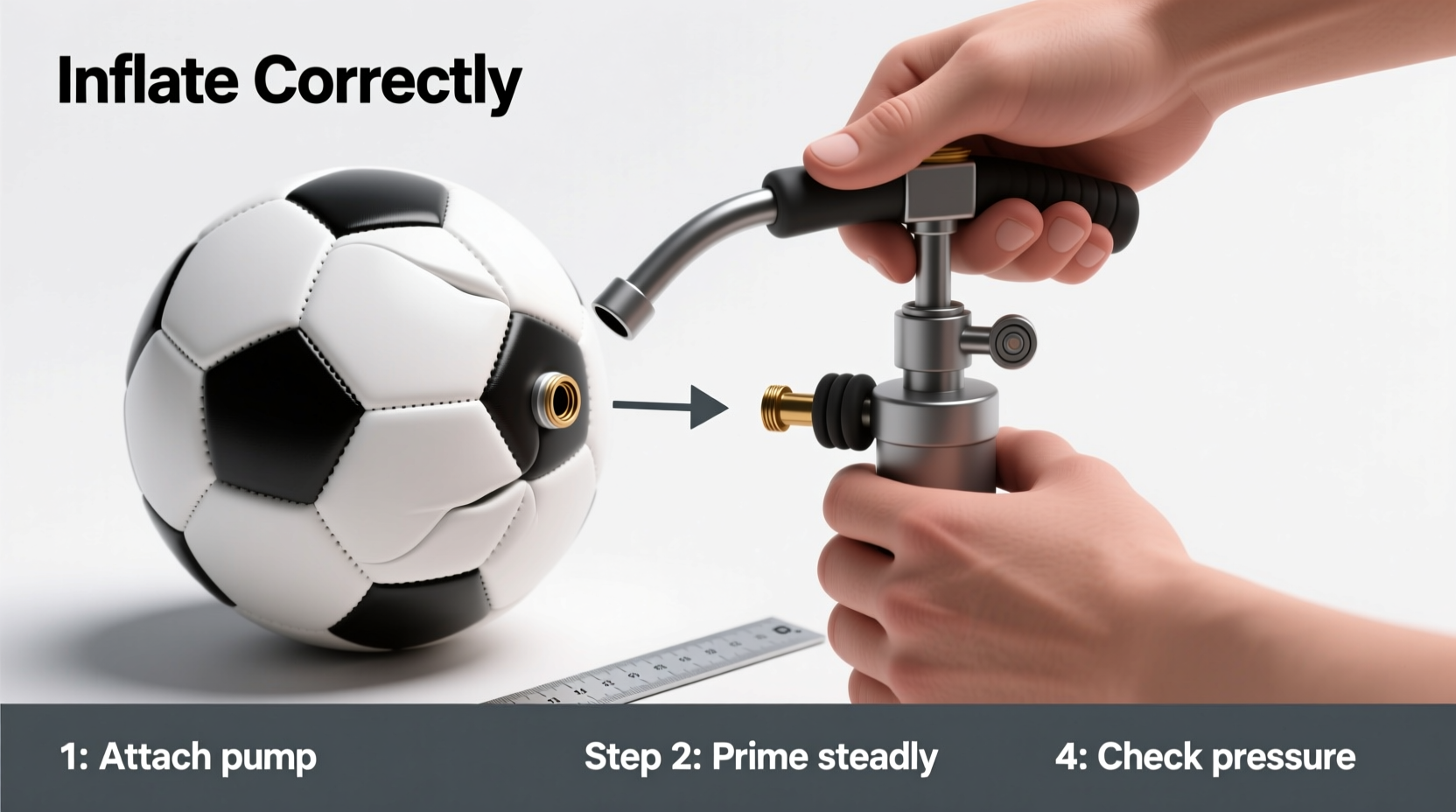Filling a football with air may seem straightforward, but doing it incorrectly can lead to uneven pressure, valve damage, or even premature wear of the ball. Whether you're preparing for a weekend match, coaching youth players, or simply maintaining your gear at home, knowing how to inflate a football properly ensures consistent bounce, better control, and longer lifespan. Using a hand pump is the most accessible method, especially when electric pumps aren't available. This comprehensive guide walks you through every stage—from selecting the right equipment to checking final pressure—with precision and care.
Understanding Football Inflation Basics

Before inflating any football, it's essential to understand what proper inflation means. Most regulation footballs require a pressure between 8.5 and 15.6 psi (pounds per square inch), depending on size, league standards, and playing surface. Under-inflated balls are sluggish and harder to pass accurately, while over-inflated ones risk bursting and offer poor touch. The sweet spot lies in balance: firm enough for responsiveness, soft enough for comfort.
The valve system on a football allows air entry via a needle attached to a pump. These valves are typically made of rubber or composite materials and can degrade if misused. Lubrication, correct needle insertion, and gradual pumping prevent leaks and internal damage.
What You’ll Need: Equipment Checklist
- A hand pump (dual-action preferred for efficiency)
- Inflation needle (usually included with the pump)
- Ball pump oil or silicone lubricant
- Pressure gauge (built-in or separate)
- Clean cloth or towel
Not all hand pumps come with a built-in pressure gauge, so having a standalone digital or analog gauge ensures accuracy. Dual-action pumps draw air on both upstroke and downstroke, reducing effort. Single-action models only pull air on the downstroke and take longer.
“Proper inflation starts with preparation. A well-lubricated needle and accurate gauge make all the difference.” — Mark Reynolds, Sports Equipment Technician, NCAA Certified
Step-by-Step Guide to Inflating a Football Correctly
- Inspect the Ball and Valve
Examine the football for cuts, bulges, or punctures. Gently press around the valve to ensure it isn’t already leaking. If the valve cap is missing, replace it after inflation to keep dirt out. - Lubricate the Inflation Needle
Dip the needle into ball pump oil or apply a small drop of silicone-based lubricant. This reduces friction during insertion and protects the rubber valve lining. Never use petroleum-based oils—they degrade rubber over time. - Insert the Needle Carefully
Align the needle straight with the valve opening. Twist gently as you push in; do not force it. Forcing can tear the inner bladder. Once fully seated, give a slight twist to lock it in place if your pump allows. - Begin Pumping Gradually
Pump slowly and steadily. Rapid strokes generate heat and increase pressure too quickly, risking overinflation. Pause every 10–15 strokes to feel the firmness and let the air distribute evenly inside the bladder. - Check Pressure Frequently
If using a built-in gauge, monitor continuously. With no gauge, remove the needle every 20 seconds and test firmness by pressing with your palm. Compare against known reference points (e.g., a properly inflated match ball). - Remove the Needle Properly
After reaching target pressure, deflate slightly (about 0.3–0.5 psi below max) to account for expansion from play-induced warmth. Then, rotate the needle counterclockwise and pull straight out. Avoid wiggling, which damages the seal. - Final Test and Clean-Up
Bounce the ball on a hard surface—it should rebound about waist-high. Wipe down the surface with a dry cloth and store the pump and needle safely.
Common Mistakes and How to Avoid Them
| Mistake | Why It’s Harmful | How to Prevent |
|---|---|---|
| Using unlubricated needles | Causes micro-tears in valve seals, leading to slow leaks | Always apply silicone lubricant before insertion |
| Over-pumping without gauges | Increases burst risk and alters ball dynamics | Use a pressure gauge and stop just below maximum rating |
| Forcing the needle at an angle | Can dislodge or warp the internal valve mechanism | Insert straight and twist gently |
| Leaving needle inserted overnight | Stresses the valve and may cause permanent deformation | Remove immediately after inflation |
Real-World Example: Youth Soccer Team Maintenance Routine
At Westside United FC, a community youth soccer club, coaches noticed frequent ball failures during games. After reviewing maintenance logs, they discovered that volunteers were inflating balls using unlubricated pumps and relying solely on \"feel.\" Within two months, nearly 40% of their training balls developed leaks.
The club introduced a standardized inflation protocol: each ball must be checked weekly, lubricated needles used exclusively, and all pumps equipped with calibrated gauges. They also trained assistant coaches in proper technique. As a result, ball replacement costs dropped by 65%, and player feedback on consistency improved significantly.
Frequently Asked Questions
How often should I check my football’s air pressure?
Check before every game or intense practice session. Temperature changes, altitude, and storage conditions affect internal pressure. Even unused balls can lose 1–2 psi per month due to natural permeability of the bladder.
Can I use a bike pump to inflate a football?
You can, but only if it has a compatible inflation needle attachment. Most bicycle pumps lack fine control and deliver high-pressure bursts unsuitable for delicate football bladders. Hand pumps designed for sports balls offer better regulation and safety.
My ball feels lopsided after inflation—what went wrong?
This usually indicates uneven air distribution or internal bladder twisting. Deflate completely, wait 10 minutes, then reinflate slowly while rotating the ball. Ensure the bladder isn’t folded during initial inflation.
Conclusion: Master the Small Details for Big Results
Inflating a football correctly is more than just adding air—it’s about preserving performance, safety, and longevity. By following this detailed process, you protect your investment and enhance gameplay quality. From lubricating the needle to monitoring pressure increments, each step contributes to a reliable, responsive ball ready for action.









 浙公网安备
33010002000092号
浙公网安备
33010002000092号 浙B2-20120091-4
浙B2-20120091-4
Comments
No comments yet. Why don't you start the discussion?